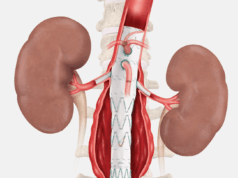 Updated recommendations on screening for abdominal aortic aneurysms (AAAs) remain consistent with the 2014 guidance while incorporating new evidence.
Updated recommendations on screening for abdominal aortic aneurysms (AAAs) remain consistent with the 2014 guidance while incorporating new evidence.
The United States Preventive Services Task Force (USPSTF) recommendation statement, published in JAMA: The Journal of the American Medical Association, was authored by a research team led by Douglas K. Owens, MD, a professor of medicine at Stanford University, Stanford, California.
The authors set the scene: “The current prevalence of AAA in the United States is unclear because of the low uptake of screening. Most AAAs are asymptomatic until they rupture. Although the risk for rupture varies greatly by aneurysm size, the associated risk for death with rupture is as high as 81%.”
The statement’s top line advisory— its B recommendation—calls for one-time screening for AAA with non-invasive conventional abdominal duplex ultrasonography in men aged 65- to 75-years-old who have ever been a smoker.
However, the USPSTF recommends selectively offering screening among men in the same age bracket who have never smoked (the C recommendation). In women 65–75 years, meanwhile, the D-graded recommendation calls for no screening in those patients who have never smoked and have no family history of AAA.
With regards to women in the same age range who have ever smoked or have a family history of AAA, the USPSTF produced the following statement: “Evidence is insufficient to assess the balance of benefits and harms of screening for AAA with ultrasonography in women aged 65 to 75 years who have ever smoked or have a family history of AAA.”
Owens et al point out that the recommendations apply to asymptomatic adults aged 50 years or older. “However, the randomized trial evidence focuses almost entirely on men aged 65 to 75 years,” they note.
Systematic review
To reach its conclusions, the USPSTF commissioned a systematic review in order to update its recommendation published five years before. The taskforce examined evidence on the effectiveness of both one-time and repeated screening for AAAs, the associated harms of screening as well as the benefits and harms of available treatments for small AAAs (3–5.4cm in diameter) that are picked up during screening. In this Recommendation Statement, the recommendations are stratified by “men” and “women,” although the net benefit estimates are driven by biologic sex (i.e., male/ female) rather than gender identity.
Ultrasonography, the primary method used to screen for AAA because of its high sensitivity (94– 100%), “is simple to perform and does not expose patients to radiation.”
Important risk factors for AAA include older age, male sex, smoking and bearing a first-degree relative with the condition, the research team writes. Others include a history of vascular aneurysms elsewhere, coronary artery disease, cerebrovascular disease, hypertension and atherosclerosis.
The presence of an AAA is typically defined as an aortic enlargement whose diameter is 3cm or larger. The USPSTF assessment of the magnitude of net benefit is listed as follows:
- Concludes with moderate certainty that screening for AAA in men aged 65 to 75 years who have ever smoked is of moderate net benefit
- Concludes with moderate certainty that screening for AAA in men aged 65 to 75 years who have never smoked is of small net benefit
- Concludes that the evidence is insufficient to determine the net benefit of screening for AAA in women aged 65 to 75 years who have ever smoked or have a family history of AAA
- Concludes with moderate certainty that the harms of screening for AAA in women aged 65 to 75 years who have never smoked and have no family history of AAA outweigh the benefits
USPSTF 2014 recommendation
The 2014 USPSTF recommendation bore a similar message: “This recommendation incorporates new evidence and replaces the 2014 USPSTF recommendation. It is consistent with the 2014 USPSTF recommendation, which was a B recommendation for one-time screening for AAA with ultrasonography in asymptomatic men aged 65 to 75 years who have ever smoked, a C recommendation for selective screening in men aged 65 to 75 years who have never smoked, a D recommendation against routine screening in asymptomatic women who have never smoked, and [what’s known as] an I statement for women aged 65 to 75 years who have ever smoked.”
In terms of treatment of AAAs picked up during screening, the authors write: “The majority of screen-detected AAAs (90%) are between 3 and 5.5cm in diameter and thus below the usual threshold for surgery. The current standard of care for patients with stable smaller aneurysms is to maintain ultrasound surveillance at regular intervals because the risk of rupture is small.
“Recommended surveillance intervals for monitoring the growth of small AAAs vary across guideline groups, and adherence with surveillance guidelines has been reported to be as low as 65%. Repairing smaller aneurysms with a lower risk of rupture increases the harms and reduces the benefits of screening.”
The authors also drew attention to the recommendations of various medical societies, including the Society for Vascular Surgery.
“The American College of Cardiology and the American Heart Association jointly recommend one- time screening for AAA with physical examination and ultrasonography in men aged 65 to 75 years who have ever smoked or in men 60 years or older who are the sibling or offspring of a person with AAA,” they wrote.
“These organizations do not recommend screening for AAA in men who have never smoked or in women. The Society for Vascular Surgery recommends one-time ultrasonography screening for AAA in all men and women aged 65 to 75 years with a history of tobacco use, men 55 years or older with a family history of AAA, and women 65 years or older who have smoked or have a family history of AAA.
“The American College of Preventive Medicine recommends one-time screening in men aged 65 to 75 years who have ever smoked; it does not recommend routine screening in women.”
SOURCE: DOI:10.1001/ JAMA.2019.18928












